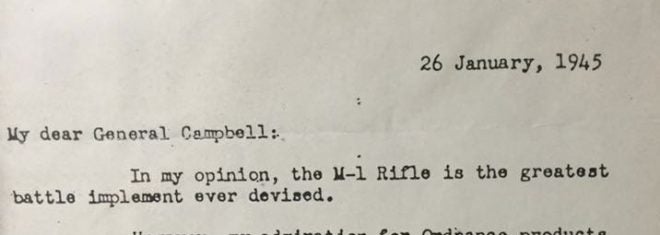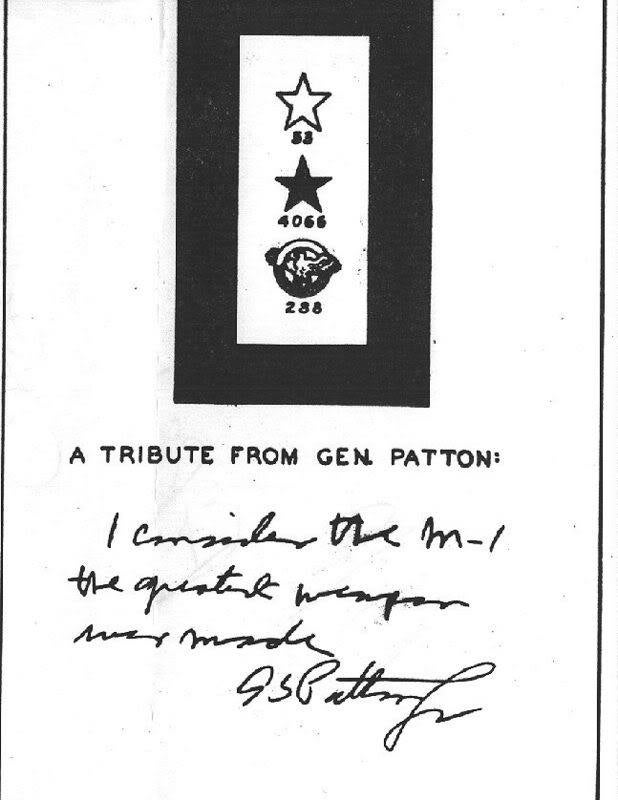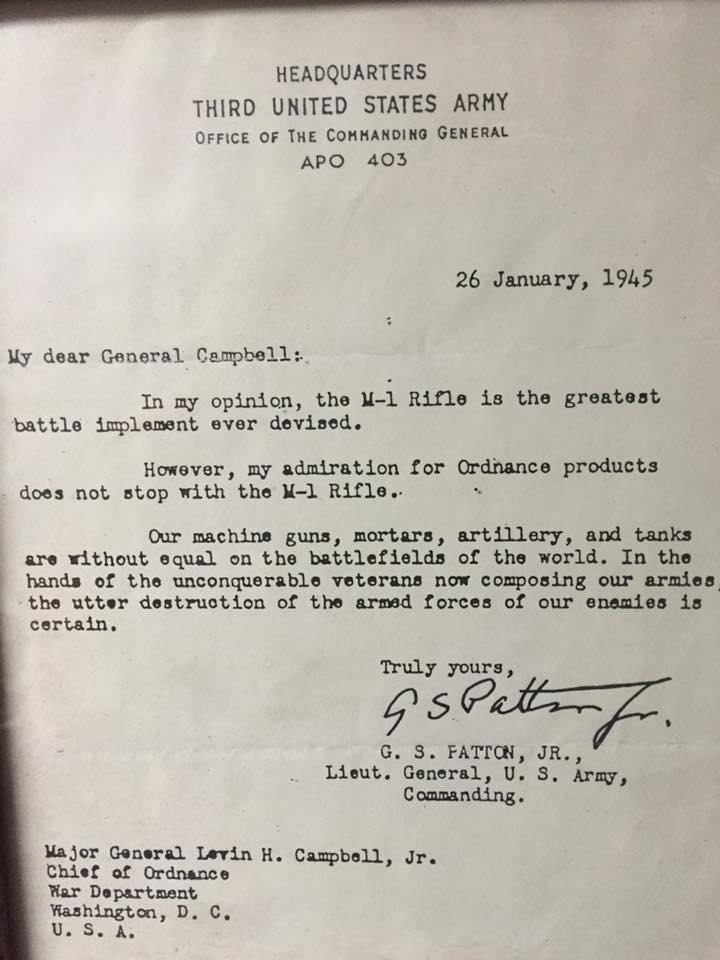The phrase, “In my opinion, the M1 Rifle is the greatest battle implement ever devised” is possibly one of the more enduring and iconic of all quotes to emerge out of the Second World War in relation to American small arms. The quote itself stems from a letter from General Patton to a certain General Campbell of the War Department. Campbell was Chief of Ordnance in 1945, the department that then directed the production and design of everything from hand grenades to the 500 pound bombs being dropped by B17s on Fortress Europe. However what must be noted is that Patton goes on to say in the letter that just about everything else the U.S. Army was using was without equal in the world. By the way, there is another letter attributed to Patton, but this one directly addressed to Springfield Armory, in which he says, “I consider the M1 the greatest weapon ever made”. Obviously the more poetic of the two found its way into the history books.
In fact, possibly due to this particular compliment, Springfield Armory commissioned an M1, just for Patton himself. Unfortunately it was never delivered to him because he died from complications in a car accident in 1945. Today the rifle is on display at the Cody Firearms Museum.
Apart from his ferocity on the battlefield as a master tactician, Patton was also known for his morale boosting speeches and tirades. Sometimes getting into alot of political trouble by making references to allying with the Soviets, or publicly humiliating soldiers suffering from Shell Shock (to which he later publicly apologized to his entire Third Army). What does this tell us about Patton’s attributions to the rifle? As much as this quote and others is overused when praising the M1, one could possibly argue that it was calculated hype, because he essentially bunches in the rest of the U.S. arsenal with the same compliment. However on the other hand, he singles out the M1 in his initial paragraph highlighting it’s significance. We’ll explore other quotes attributed to him, and their context, in the proceeding paragraphs.
In addition we have this document, dated to April 1944, and known as a Letter of Instruction Number 2. In it Patton expounds his advice for his infantrymen in their tactical conduct on the battlefield, with very specific reference to the M1 rifle. He mentions numerous other small arms and light weapons, to include the 81mm, 60mm mortars, and machine guns, but nowhere else does he again single out a weapon system for its significance.
Headquarters
Third United States Army
APO 403 U.S. Army3 April, 1944
Subject: Letter of Instruction Number 2
To: Corps, Division, and Separate Unit CommandersIII. Tactical Usages
….
b. The heavy weapons set the pace. In the battalion the heavy weapons company paces the battalion. In the regiment the cannon company paces the regiment, but it is the function of the rifles and the light machine guns to see that the heavy weapons have a chance to move. In other words, the rifles and machine guns move the heavy weapons in to do the killing.
f. The M-1 rifle is the most deadly rifle in the world. If you cannot see the enemy, you can at least shoot at the place where he is apt to be.
Again, on Page 339 of his autobiography there is another direct compliment to the M1, one of the other more often quoted sayings of Patton,
When you get to three hundred yards, your own small-arms fire, which is superior to anything now existing or which will probably ever exist, will neutralize that the enemy small-arms fire..
.Marching Fire: The proper way to advance, particularly for troops armed with that magnificent weapon, the M-1 rifle, is to utilize marching fire and keep moving.
However, in the same paragraph he has this-
The whistle of the bullets, the scream of the ricochet, and the dust, twigs, and branches which are knocked from the ground and the trees have such an effect on the enemy that his small-arms fire becomes negligible.
Volume of fire versus accuracy of fire has always been a hotly contested debate within many Infantry circles. During the Marine Corps’ M27 competition this was one of the advantages seen against the M249 SAW, in that only accurate effects on target, will more likely lead to killing or wounding enemy troops, and thus will carry an attack. I personally believe that a large volume of inaccurate or sporadic fire, will probably only embolden an enemy to increase his own rate of fire, and even further to end the attack he is being faced with. Patton is essentially arguing that there isn’t a need to actually have effective rounds on target, instead just make sure all your rounds get in the vicinity of the enemy. Taken with this spirit, one could even argue that Patton could have been somewhat delusional when it comes to the execution of small unit tactics. Indeed, on the next page the General proposes that, “The light machine guns [1919A4s] can be used while walking-one man carrying the belt, the other man carrying the gun”. I’ve pointed this out before, but shoulder firing a medium machine gun such as a M240B, or a PKM is probably more detrimental than anything else. But with a period M1919A4 that Patton is referencing, there is no shouldering, only hip firing, which quite quantifies “Spray and Pray”. Again, I find this somewhat illusionary and wishful thinking. Especially at the ranges in which small arms were employed in the European Theater of Operations.
Often we presume that the M1 gave American forces a superior advantage on the battlefield, being the first mass produced and mass issued semi-automatic rifle in military history. But could a rifle have really been the decisive? Would the war in Europe had lasted several months longer had American forces been equipped with the bolt action M1903A3, or even the M1917 Enfield? I would wager a bet that it wouldn’t have. After all, the Japanese Army lasted much longer than the German Army did, equipped with bolt action Type 99 rifles. Granted, there is historical evidence that Japanese banzai charges were typically successful when dealing with forces of similarly armed bolt action rifles. Firearms historian Philip Schreier tells us this–
Before the M1 came along, Japanese “banzai charges” had been successful against infantrymen armed with bolt-action rifles, but when they came up against U.S. infantrymen armed with M1s, the Japanese’s charges often ended in catastrophes for the Japanese, as they were cut down by this formidable rifle’s .30-06 cartridge fired with eight fast presses of a trigger. Once emptied, the clip flew free as the action on the rifle locked back; this allowed soldiers to simply stuff in another clip of eight more rounds. Compared to other arms used at the time, this made the M1 Garand an impressive weapon when in the hands of trained infantrymen.
The use of semi-automatic Garands certainly helped stop Banzai charges in the beginning of the war, but Japanese officers realized what they were dealing with, and quickly changed tactics that completely excluded and even in some cases forbid banzai charges. Some of the most costliest islands of the entire campaign in the Pacific were Iwo Jima and Okinawa, where there were relatively no banzai charges at all. My point is that although the Garand contributed to stopping Banzai charges, the overall effect of the rifle was probably very minimal, because Japanese troops simply changed tactics better suited to the new warfare they were encountering, and with devastating results.
Arguably the sheer industrial and logistical capacity to produce everything from 1911s to B29 Superfortresses with reliable quality control is the true instrument that made a difference against the Axis Powers. With the M1 of course becoming a byproduct of that. Either way, I’m sure GIs were much more comfortable with a semi-automatic rather than a bolt action rifle platform in the Greatest Generation’s campaigns against tyranny.
Much thanks to Daniel Waters for contributing the document photographs published in this article!
 Your Privacy Choices
Your Privacy Choices


